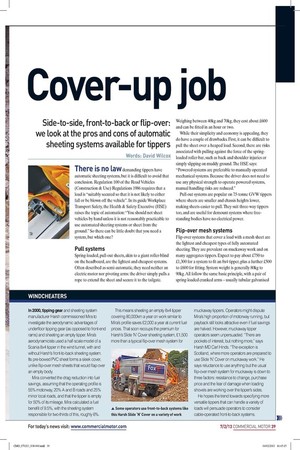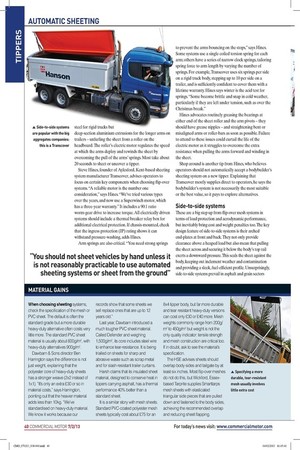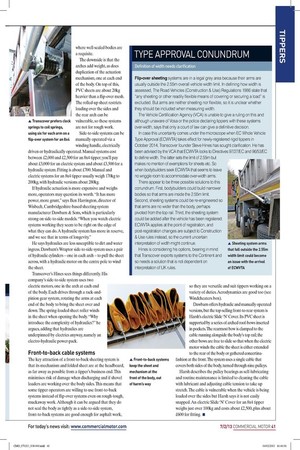Cover up job Side-to-side, front-to-back or flip-o
Page 31

Page 32

Page 33

If you've noticed an error in this article please click here to report it so we can fix it.
Cover up job Side-to-side, front-to-back or flip-over: we look at the pros and cons of automatic sheeting systems available for tippers Words: David Wilcox There is no law demanding tippers have automatic sheeting systems, but it is difficult to avoid that conclusion. Regulation 100 of the Road Vehicles (Construction & Use) Regulations 1986 requires that a load is "suitably secured so that it is not likely to either fall or be blown off the vehicle". In its guide Workplace Transport Safety, the Health & Safety Executive (HSE) raises the topic of automation: "You should not sheet vehicles by hand unless it is not reasonably practicable to use automated sheeting systems or sheet from the ground." So there can be little doubt that you need a system, but which one?
Pull systems Spring-loaded, pull-out sheets, akin to a giant roller-blind on the headboard, are the lightest and cheapest systems. Often described as semi-automatic, they need neither an electric motor nor pivoting arms: the driver simply pulls a rope to extend the sheet and secure it to the tailgate.
Weighing between 40kg and 70kg, they cost about £600 and can be fitted in an hour or two.
While their simplicity and economy is appealing, they do have a couple of drawbacks. First, it can be difficult to pull the sheet over a heaped load. Second, there are risks associated with pulling against the force of the springloaded roller-bar, such as back and shoulder injuries or simply slipping on muddy ground. The HSE says: "Powered systems are preferable to manually operated mechanical systems. Because the driver does not need to use any physical strength to operate powered systems, manual handling risks are reduced."
Pull-out systems are popular on 7.5-tonne GVVV tippers where sheets are smaller and chassis heights lower, making sheets easier to pull. They suit three-way tippers too, and are useful for demount systems where freestanding bodies have no electrical power.
Flip-over mesh systems Flip-over systems that cover a load with a mesh sheet are the lightest and cheapest types of fully automated sheeting. They are prevalent on muckaway work and on many aggregates tippers. Expect to pay about £750 to £1,300 for a system to fit an 8x4 tipper, plus a further £500 to £600 for fitting. System weight is generally 80kg to 90kg. All follow the same basic principle, with a pair of spring-loaded cranked arms — usually tubular galvanised steel for rigid trucks but deep-section aluminium extrusions for the longer arms on trailers — unfurling the sheet from a roller on the headboard. The roller's electric motor regulates the speed at which the arms deploy and rewinds the sheet by overcoming the pull of the arms' springs. Most take about 20 seconds to sheet or uncover a tipper.
Steve Hines, founder of Aylesford, Kent-based sheeting system manufacturer Transcover, advises operators to focus on certain key components when choosing flip-over systems. "A reliable motor is the number one consideration," says Hines. "We've tried various types over the years, and now use a Superwinch motor, which has a three-year warranty." It includes a 90:1 ratio worm-gear drive to increase torque. All electrically driven systems should include a thermal breaker relay box for additional electrical protection. If chassis-mounted, check that the ingress protection (IP) rating shows it can withstand pressure-washing, adds Hines.
Arm springs are also critical. "You need strong springs to prevent the arms bouncing on the stops," says Hines. Some systems use a single coiled torsion spring for each arm; others have a series of narrow clock springs, tailoring spring force to arm length by varying the number of springs. For example, Transcover uses six springs per side on a rigid truck body, stepping up to 10 per side on a trailer, and is sufficiently confident to cover them with a lifetime warranty. Hines says winter is the acid test for springs. "Some become brittle and snap in cold weather, particularly if they are left under tension, such as over the Christmas break."
Hines advocates routinely greasing the bearings at either end of the sheet roller and the arm pivots — they should have grease nipples — and straightening bent or misaligned arms or roller-bars as soon as possible. Failure to attend to these issues could curtail the life of the electric motor as it struggles to overcome the extra resistance when pulling the arms forward and winding in the sheet.
Shop around is another tip from Hines, who believes operators should not automatically accept a bodybuilder's sheeting system on a new tipper. Explaining that Transcover mostly supplies direct to operators, he says the bodybuilder's system is not necessarily the most suitable or the best value, so it pays to explore alternatives.
Side-to-side systems These are a big step up from flip-over mesh systems in terms of load protection and aerodynamic performance, but inevitably bring cost and weight penalties too. The key design feature of side-to-side systems is their arched end-plates at front and back. They not only provide clearance above a heaped load but also mean that pulling the sheet across and securing it below the body's top rail exerts a downward pressure. This seals the sheet against the body, keeping out inclement weather and contamination and providing a sleek, fuel-efficient profile. Unsurprisingly, side-to-side systems prevail in asphalt and grain sectors where well-sealed bodies are a requisite.
The downside is that the arches add weight, as does duplication of the actuation mechanism, one at each end of the body. On top of this, PVC sheets are about 20kg heavier than a flip-over mesh. The rolled-up sheet restricts loading over the sides and the rear arch can be vulnerable, so these systems are not for rough work.
Side-to-side systems can be manually operated via a winding handle, electrically driven or hydraulically operated. Manual systems cost between £2,000 and £2,500 for an 8x4 tipper; you'll pay about £3,000 for an electric system and about £3,500 for a hydraulic system. Fitting is about £700. Manual and electric systems for an 8x4 tipper usually weigh 170kg to 200kg, with hydraulic versions about 280kg.
If hydraulic actuation is more expensive and weighs more, operators may question its worth. "It has more power, more grunt," says Ben Harrington, director of Wisbech, Cambridgeshire-based sheeting system manufacturer Dawbarn & Sons, which is particularly strong on side-to-side models. "When you watch electric systems working they seem to be right on the edge of what they can do. A hydraulic system has more in reserve, and we see that in terms of longevity."
He says hydraulics are less susceptible to dirt and water ingress. Dawbam's Wraptor side-to-side system uses a pair of hydraulic cylinders — one in each arch — to pull the sheet across, with a hydraulic motor on the centre pole to wind the sheet.
Transcover's Hines sees things differently. His company's side-to-side system uses two electric motors, one in the arch at each end of the body. Each drives through a rack-andpinion gear system, rotating the arms at each end of the body to bring the sheet over and down. The spring-loaded sheet roller winds in the sheet when opening the body. "Why introduce the complexity of hydraulics?" he argues, adding that hydraulics are underpinned by electrics anyway, namely an electro-hydraulic power-pack.
Front-to-back cable systems The key attraction of a front-to-back sheeting system is that its mechanism and folded sheet are at the headboard, as far away as possible from a tipper's business end. This minimises risk of damage when discharging and if shovel loaders are working over the body sides. This means that some tipper operators are willing to use front-to-back systems instead of flip-over systems even on rough-tough, muckaway work. Although it can be argued that they do not seal the body as tightly as a side-to-side system, front-to-back systems are good enough for asphalt work, so they are versatile and suit tippers working on a variety of duties. Aerodynamics are good too (see Windcheaters box).
Dawbam offers hydraulic and manually operated versions, but the top-selling front-to-rear system is Harsh's electric Slide 'N' Cover. Its PVC sheet is supported by a series of arched roof-bows inserted in pockets. The rearmost bow is clamped to the cable running alongside the body's top rail; the other bows are free to slide so that when the electric motor winds the cable the sheet is either extended to the rear of the body or gathered concertinafashion at the front. The system uses a single cable that covers both sides of the body, turned through nine pulleys.
Harsh describes the pulley bearings as self-lubricating and routine maintenance is limited to cleaning the cable with lubricant and adjusting cable tension to take up stretch. The cable is vulnerable when the vehicle is being loaded over the sides but Harsh says it is not easily snapped. An electric Slide 'N' Cover for an 8x4 tipper weighs just over 100kg and costs about £2,500, plus about £600 for fitting. • WINDCHEATERS In 2000, tipping gear and sheeting system manufacturer Harsh commissioned Mira to investigate the aerodynamic advantages of underfloor tipping gear (as opposed to front-end rams) and sheeting an empty tipper. Mira's aerodynamicists used a half-scale model of a Scania 8x4 tipper in the wind tunnel, with and without Harsh's front-to-back sheeting system. Its pre-bowed PVC sheet forms a sleek cover, unlike flip-over mesh sheets that would flap over an empty body.
Mira converted the drag reduction into fuel savings, assuming that the operating profile is 55% motorway, 20% A and B roads and 25% minor local roads, and that the tipper is empty for 50% of its mileage. Mira calculated a fuel benefit of 9.5%, with the sheeting system responsible for two-thirds of this, roughly 6%.
This means sheeting an empty 8x4 tipper covering 80,000km a year on work similar to Mira 's profile saves £2,000 a year at current fuel prices. That soon recoups the premium for Harsh's Slide 'N' Cover sheeting system, £1,500 more than a typical flip-over mesh system for muckaway tippers. Operators might dispute Mira's high proportion of motorway running, but payback still looks attractive even if fuel savings are halved. However, muckaway tipper operators seem unpersuaded. "There are pockets of interest, but nothing more," says Harsh MD Carl Hinds. "The exception is Scotland, where more operators are prepared to use Slide 'N' Cover on muckaway work." He says reluctance to use anything but the usual flip-over mesh system for muckaway is down to three factors: resistance to change, purchase price and the fear of damage when loading shovels are working over the tipper's sides.
He hopes the trend towards specifying more versatile tippers that can handle a variety of loads will persuade operators to consider cable-operated front-to-back systems.
MATERIAL GAINS When choosing sheeting systems, check the specification of the mesh or PVC sheet. The default is often the standard grade but a more durable heavy-duty alternative often costs very little more. The standard PVC sheet material is usually about 600g/m2, with heavy-duty alternatives 900g/m2.
Dawbarn & Sons director Ben Harrington says the difference is not just weight, explaining that the polyester core of heavy-duty sheets has a stronger weave (2x2 instead of 1x1). "It's only an extra £30 or so in material costs," says Harrington, pointing out that the heavier material adds less than 10kg. "We've standardised on heavy-duty material. We know it works because our records show that some sheets we sell replace ones that are up to 12 years old."
Last year, Dawbarn introduced a much tougher PVC sheet material. Called Defender and weighing 1,500g/m2, its core includes steel wire to enhance tear-resistance. It is being trialled on sheets for sharp and abrasive waste such as scrap metal and for slash-resistant trailer curtains.
Harsh claims that its insulated sheet material, designed to conserve heat in tippers carrying asphalt, has a thermal performance 40% better than a standard sheet.
It is a similar story with mesh sheets. Standard PVC-coated polyester mesh sheets typically cost about £75 for an 8x4 tipper body, but far more durable and tear resistant heavy-duty versions can cost only £30 or £40 more. Mesh weights commonly range from 200g/ m2 to 450g/m2 but weight is not the only quality indicator: tensile strength and mesh construction are critical too. If in doubt, ask to see the material's specification.
The HSE advises sheets should overlap body sides and tailgate by at least six inches. Most flip-over meshes do not do this, but Wickford, Essexbased Tarprite supplies Smarttarps mesh sheets with elasticated triangular side pieces that are pulled down and fastened to the body sides, achieving the recommended overlap and reducing sheet flapping.
TYPE APPROVAL CONUNDRUM Definition of width needs clarification Flip-over sheeting systems are in a legal grey area because their arms are usually outside the 2.55m overall vehicle width limit. In defining how width is assessed, The Road Vehicles (Construction & Use) Regulations 1986 state that "any sheeting or other readily flexible means of covering or securing a load" is excluded. But arms are neither sheeting nor flexible, so it is unclear whether they should be included when measuring width.
The Vehicle Certification Agency (VCA) is unable to give a ruling on this and although unaware of Vosa or the police declaring tippers with these systems over-width, says that only a court of law can give a definitive decision.
In case this uncertainty comes under the microscope when EC Whole Vehicle Type Approval (ECWVTA) takes effect for newly-registered rigid tippers in October 2014, Transcover founder Steve Hines has sought clarification. He has been advised by the VCA that ECWVTA looks to Directives 97/27/EC and 96/53/EC to define width. The latter sets the limit of 2.55m but makes no mention of exemptions for sheets etc. So when bodybuilders seek ECWVTA that seems to leave no wriggle room to accommodate over-width arms.
There appear to be three possible solutions to this conundrum. First, bodybuilders could build narrower bodies so that arms are inside the 2.55m limit. Second, sheeting systems could be re-engineered so that arms are no wider than the body, perhaps pivoted from the top rail. Third, the sheeting system could be added after the vehicle has been registered. ECWVTA applies at the point of registration, and post-registration changes are subject to Construction & Use rules instead, so the current uncertain interpretation of width might continue. A Sheeting system arms Hines is considering his options, bearing in mind that fall outside the 2.55m that Transcover exports systems to the Continent and width limit could become so needs a solution that is not dependent on an issue with the arrival interpretation of UK rules. of ECWVTA








































